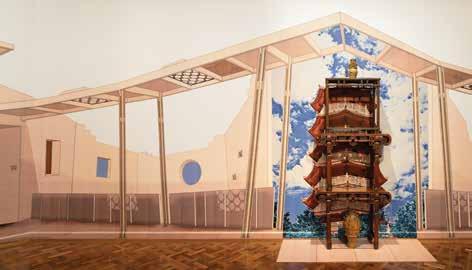TAASA Review



Jackie Menzies
he Illawarra Pavilion was a magical, stimulating and poetic installation shown 13-29 May within the Wollongong Art Gallery (WAG). Created by artist Gary Carsley and architect Renjie Teoh, in a ‘collusion’ known as the ArtHitects, the Pavilion and the concepts intrinsic to its multidisciplinary realisation are sure to serve as a template for future installations.
Important from an Asian perspective was the integration of diverse Asian practices and objects into the immersive experience of the Pavilion. In drawing together geographically, culturally and temporally unrelated objects and concepts within a teasingly ambiguous space, the artists generated exciting new synergies. Their sophisticated and sensitive awareness of diverse elements from different cultures reflects the currents of change, adaptation and ‘evolving aesthetics’ (Online catalogue: 10) shaping their own vision and those of the broader community.
A pavilion is synonymous with views of landscape and garden. In the case of the Illawarra Pavilion the landscape vistas, the architectural structures such as covered walkways, stairways, windows and skylights, together with the carved wall panels, are all ‘wallpaper’ illusions confabulated out of 3,563 overlapping 80gsm A4 coloured photocopier printed sheets attached to the walls to create an illogical ‘Wonderland’ space that frees the viewer from any normal expectations of an exhibition. The numerous unorthodox vignettes excite and engage as one moves around the space, enjoying views of the untamed Illawarra landscape through Chinese carved lacquer doors, peering up stairways to heaven and examining fine Chinese ceramics and lacquer.
The vistas recall the ‘borrowed scenery’ of East Asian garden design whereby distant scenery is incorporated into a setting to become an animating component. A multilevel play is in operation: photographic views of the Illawarra landscape serve as effective surrogates for a true view while the superimposed relief outline of a traditional Chinese vase contains and ‘orientalises’ the landscape. Chinese carved lacquer doors that open onto the vistas play with the exterior/interior flow of contemporary architectural practice while the imagination is continually engaged with the External/Internal, Other/Local
COVERED GARDEN WALKWAY AND PAGODA 2022 WITH THREE TRADITIONAL CHINESE TABLES (PAIR OF ROSEWOOD ALTAR TABLES C.1910, HARDWOOD SIDE TABLE C.1700-1800S); EARTHENWARE BURIAL JAR C.300-400S, STONEWARE FUNERARY URN, 265-317 AD. MANN-TATLOW COLLECTION OF ASIAN ART. PHOTO: BY THE ARTHITECTS

dichotomy of unexpected juxtapositions. A living evocation of the Illawarra escarpment that Teoh calls his ‘bowlscape’, a miniature hortus conclusus (enclosed garden) held in a large contemporary bowl-pond, transforms the illusionistic external landscapes into real nature while expanding and localising the long East Asian tradition of bonsai.
These illusionistic devices accentuate the materiality of the objects within the central space which is defined by a peristyle composed of translucent square pillars subtly evocative of Asian sacred spaces. The illogical, even disorienting, challenges offered by the vistas and architectural references continue within this space with the gentle disruption and questioning of traditional aesthetic hierarchies by, for example, the intervention of contemporary router-cut flatpack plywood side tables among fine examples of antique Chinese lacquer, furniture and ceramics from WAG’s Mann-Tatlow Collection of Asian Art.
While the landscape vistas and architecture allude to things familiar, the variegated patterned wall panels derived from traditional Chinese motifs such as open wood lattice panels or deeply carved lacquer doors add a novel, exotic, even Chinoiserie flavour. The patterned wall panels were created by selecting parts of Chinese furniture, for example the carved panels of a traditional Chinese cabinet, and photographing them at a high enough resolution to produce scaled-up versions for the gridded wall paper substrate that so effectively covers some walls. Some real lacquer doors were incorporated into the installation, to open onto their own
illusionistic vista. Thus artworks, patterned paper, photographic views of nature are juxtaposed in unexpected yet lyrical ways.
The online catalogue presents numerous photographs of the installation, its components and construction process, together with essays that articulate the concepts behind the images to which we so viscerally respond. An article by Candace Richards and the ArtHitects proffers the word ‘spolia’, usually found in relation to archaeology, to explain the re-purposing of materials from their original context into a new one that re-animates them and stimulates new meanings and appreciation. This is exemplified in the novel stacking of three traditional Chinese altar tables against the view of a pagoda against the blue sky.
Credit to WAG for commissioning this inspirational installation, and for the many other engaging exhibitions they generate. Although the Pavilion might have gone, to live on in successive re-iterations, the show Echoes in Time which displays contemporary collection works that reflect the technical and aesthetic qualities of Asian ceramics in response to the Mann-Tatlow Collection of Asian Art is on until 31 July. WAG regularly presents new approaches to Asian and Australian-Asian art and it is always worth checking their program for upcoming exhibitions.
Jackie Menzies is President of TAASA.
http://www.wollongongartgallery.com/exhibitions/Pages/IllawarraPavilion.aspx